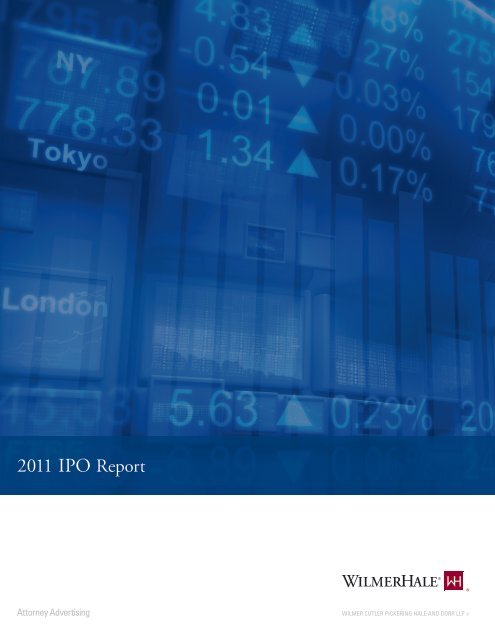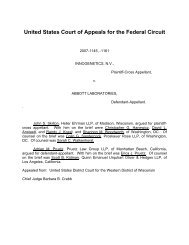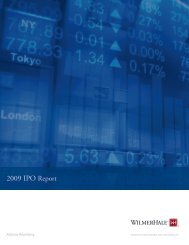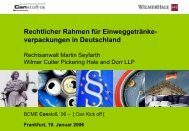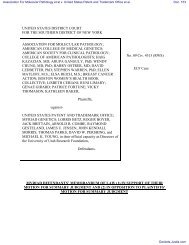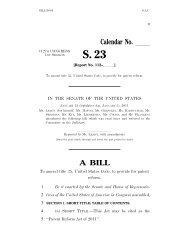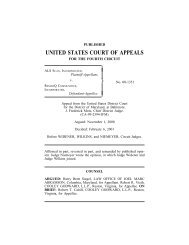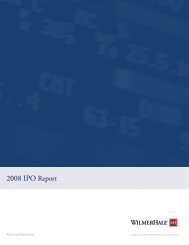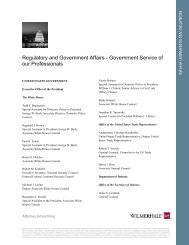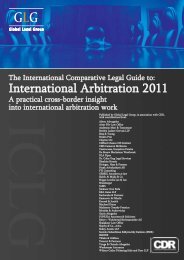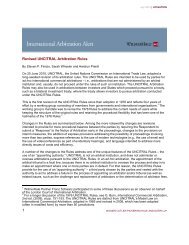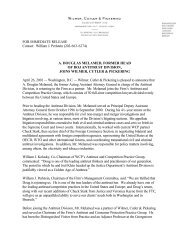2011 IPO Report - WilmerHale
2011 IPO Report - WilmerHale
2011 IPO Report - WilmerHale
Create successful ePaper yourself
Turn your PDF publications into a flip-book with our unique Google optimized e-Paper software.
<strong>2011</strong> <strong>IPO</strong> <strong>Report</strong>Attorney Advertising
Table of Contents26810121416US <strong>IPO</strong> Market Review and OutlookLaw Firm and Underwriter RankingsSelected <strong>WilmerHale</strong> Public OfferingsRegional <strong>IPO</strong> Market Review and Outlook– California– Mid-Atlantic– New England– Tri-StateSpecial Issues for Special IssuersPost-<strong>IPO</strong> Financing TechniquesInitial Public Offerings: A Practical Guide to Going Public
2 US <strong>IPO</strong> Market Review and OutlookUS <strong>IPO</strong> Market Review and Outlook 3Market ReviewThe <strong>IPO</strong> market continued to reboundthroughout 2010, producing 142 <strong>IPO</strong>s.The year’s total was almost triple thetally of 54 <strong>IPO</strong>s in 2009, which itselfrepresented a significant step up fromthe paltry output of 31 <strong>IPO</strong>s in 2008—the lowest annual count since 1975.The momentum that brought a spike indeal volume at the end of 2009 continuedthroughout 2010, as both economic andcapital market conditions improved.Quarterly volume ranged from 24 to34 <strong>IPO</strong>s in the first three quarters of2010. Deal flow jumped to 54 <strong>IPO</strong>s inthe fourth quarter of 2010—equal tothe full-year 2009 total—enabling themarket to enter <strong>2011</strong> on a high note.The 142 <strong>IPO</strong>s in 2010 generated grossproceeds of $36.3 billion, with bothfigures representing the largest totalssince 2007. Boosted by General Motors’gargantuan $20.1 billion offering—the largest <strong>IPO</strong> in US history—grossproceeds in 2010 were nearly doublethe prior year’s total of $19.2 billion.Although it pales next to the annualaverage of 500-plus <strong>IPO</strong>s of the late 1990s,the total of 142 <strong>IPO</strong>s in 2010 approachedthe annual run rate of about 200 <strong>IPO</strong>sthat prevailed from 2004 to 2007.Individual components of the <strong>IPO</strong>market fared as follows in 2010:■The number of venture capital–backed<strong>IPO</strong>s soared to 46 in 2010. This dealvolume was a welcome relief to venturecapitalists, who had suffered throughthe dark days of 2008 and 2009 witha two-year total of only 15 offerings.At 32%, the 2010 market share forVC-backed <strong>IPO</strong>s was consistent withhistorical patterns. Most of theseventure capital–backed <strong>IPO</strong>s were bycompanies in technology or life sciences.■Private equity–backed <strong>IPO</strong>s grabbed 27%of the market in 2010, with 39 offerings.Financial sponsors, hobbled by tightcredit from late 2007 through 2009, wereanxious to take their portfolio companiespublic. PE-backed companies tend to belarge and mature and to produce verylarge <strong>IPO</strong>s, such as those of Hyatt Hotelsin 2009 and Sensata Technologies in 2010.US <strong>IPO</strong>s – 1996 to 2010866987681996US issuersSource: SEC filingsForeign issuersUS <strong>IPO</strong> Dollar Volume – 1996 to 201048.810.038.81996619975221997US issuers Foreign issuers $ billions59.728.9Source: SEC filings3534331019988.730.8 32.1199740.8199853757480199995.333.761.61999446107■The technology sector remainedstrong in 2010. Tech-related companiesproduced 53% of the year’s <strong>IPO</strong>s,down slightly from 56% in 2009.■Foreign issuers accounted for 39% ofthe market in 2010, the highest suchpercentage in at least 15 years. Chinacontinued to be the predominantsource of foreign-issuer <strong>IPO</strong>s in theUnited States, producing a staggeringtotal of 40 <strong>IPO</strong>s—which represented28% of the entire US market in 2010.With a total offering size of $20.1 billion,General Motors produced the largest3392000108.252.755.5200091 75 7114 9 1077 1466 9 61 102001 2002 200341.39.132.2200125.46.419.0200215.26.19.12003205 190 198 20734 32 35 58171 158 163 149200420052006200746.539.0 31.440.415.38.7 5.2 10.930.326.229.4 31.3200420052006200731922200824.10.823.3 0.8200854 14215553987152009 201019.26.712.52009<strong>IPO</strong> of the year, by a wide margin. Theyear’s next-largest <strong>IPO</strong>s were fromSwift Transportation ($806.3 million),SMART Technologies ($660.1 million)and Oasis Petroleum ($588.0 million).36.37.129.22010Aftermarket performance was stronger in2010 than in 2009. The average 2010 <strong>IPO</strong>appreciated 28% by the end of the year,and 68% of the year’s <strong>IPO</strong>s were trading ator above their offering price at year-end.In 2009, the average <strong>IPO</strong> appreciated 18%during the year, and 65% of the year’s <strong>IPO</strong>swere trading at or above their offering priceat year-end. In sharp contrast, the average2008 <strong>IPO</strong> was 36% below its offeringprice at the end of 2008, and only 16% ofthat year’s <strong>IPO</strong>s were trading at or abovetheir offering price at year-end 2008.In 2010, there was only one “moonshot”(an <strong>IPO</strong> that doubles in price on itsopening day)—Chinese Internet TVcompany Youku.com jumped 161%in first-day trading. The year’s othertop performers out of the blocks wereChinaCache International Holdings (up95% on its opening day), MakeMyTrip (up89%) and E-Commerce China Dangdang(up 87%). Overall, all but one of the year’stop-ten first-day gains came from <strong>IPO</strong>sby foreign issuers, and Chinese issuersaccounted for seven of the top ten.<strong>IPO</strong> companies were smaller and lessprofitable in 2010 than in recent years.The percentage of profitable companiesgoing public dropped from a record82% in 2009 to 59% in 2010—the lowestpercentage since the tail of the dotcomboom in 2001. The median annualrevenue of <strong>IPO</strong> companies plunged from$229.0 million in 2009 to $100.8 millionin 2010. Both metrics reversed, at leasttemporarily, a long-term trend towardlarger and more profitable <strong>IPO</strong> companies.In 2010, 49 <strong>IPO</strong>s were completed bycompanies based in the eastern UnitedStates (east of the Mississippi River),western US–based issuers accountedfor 38 <strong>IPO</strong>s, and foreign issuersaccounted for the remaining 55 <strong>IPO</strong>s.OutlookIn broad terms, the US <strong>IPO</strong> markethas gone through six phases overthe past two decades or so:■1991 to 1998—Reasonably stable market,producing an average of 565 <strong>IPO</strong>s per year■1999 and 2000—Go-go marketcharacterized by marginally qualified <strong>IPO</strong>companies and rampant price euphoria(although annual deal volume was 13%lower than in the preceding eight years)■2001 to mid-2003—Very selectivemarket, in which deal volumes fellsubstantially and <strong>IPO</strong> candidates wereheld to much higher standardsPercentage of Profitable <strong>IPO</strong> Companies – 1998 to 2010%56199835.0199826 261999Source: <strong>IPO</strong> Vital Signs200017.9 17.619992000■Mid-2003 through 2007—Solidmarket recovery, although notapproaching the deal volumes thatprevailed for most of the 1990s■2008—Market bottoms out underthe combined burden of an economicrecession and plunging capital markets■2009 and 2010—Market reboundsfrom historic lows, but not yet tothe deal levels of 2004 to 2007We remain fundamentally optimisticabout the long-term prospects for the <strong>IPO</strong>market. The continuation and expansionof the <strong>IPO</strong> market recovery will depend on522001161.02001612002Median Annual Revenue of <strong>IPO</strong> Companies – 1998 to 2010$ millionsSource: <strong>IPO</strong> Vital Signs267.52002652003144.5200359200485.72004622005642006105.9 111.12005200662200787.02007a number of factors. The major factors areneither mysterious nor easy to predict:■Economic Conditions: Economic growthis a key determinant of strength in thecapital markets. By late 2007, five years ofeconomic expansion—largely driven bystrong consumer spending, boosted bylow interest rates, tax cuts and increasedborrowing against home equity—hadsputtered to an end. The recession thatfollowed was longer and more severe thanalmost anyone anticipated. Althoughit had begun to recover by mid-2009,the economy has continued to send712008113.52008822009229.02009592010100.82010
4 US <strong>IPO</strong> Market Review and Outlook US <strong>IPO</strong> Market Review and Outlook 5mixed signals and the timing and extentof economic growth is uncertain.■Capital Market Conditions: Stable androbust capital markets are a leadingindicator of <strong>IPO</strong> activity. After sharplydeclining in 2008, the Nasdaq stabilized inthe first quarter of 2009 and then surgedto post a full-year gain of 44% by yearend.Similarly, the Dow recovered fromits March low point and increased 19%for all of 2009. In 2010, the Nasdaq grewanother 17% and the Dow tacked on 11%.■Institutional Appetite: <strong>IPO</strong>s are relativelyrisky investments, so the appetite ofinstitutional investors for risk capitalaffects the <strong>IPO</strong> market. When otherparts of a portfolio feel risky, investorsmay stay away. These players are criticalto the health of the <strong>IPO</strong> market.■Impact of Regulatory Environment: Thecorporate governance reforms resultingfrom the adoption of the Sarbanes-OxleyAct in 2002 and the Dodd-Frank Act in2010 have created new responsibilitiesfor public companies and their directorsand officers. These changes have helpedimprove accountability to stockholders,board oversight of management, boardmember qualifications and investorconfidence—but have also increasedthe cost of being public, both in termsof potential liability and the expenseof compliance. The more rigorouscorporate governance environmentmay deter some <strong>IPO</strong> candidates.For most companies, however, thenew and enhanced governancerequirements can be assimilated into<strong>IPO</strong> planning and should not pose amajor impediment to going public.Moreover, many of the consequences ofthese requirements—such as a robustfinance and accounting organization—are needed in a growing enterprise,whether or not it ever pursues an <strong>IPO</strong>.■Venture Capital Pipeline: Venturecapitalists depend on <strong>IPO</strong>s—along withcompany sales—to provide liquidity totheir investors. With the large increasein <strong>IPO</strong>s by venture capital–backedcompanies in 2010, the number ofVC-backed companies entering <strong>IPO</strong>registration, or resuscitating dormantfilings, has been increasing. Longerterm, the pool of <strong>IPO</strong> candidates willbe affected by current trends in ventureMedian <strong>IPO</strong> Offering Size – 1996 to 2010$ millions30.01996Source: SEC filingsVenture Capital–Backed <strong>IPO</strong>s – 1996 to 201021615.033.01997# of deals Median amount raised prior to <strong>IPO</strong> (in $ millions)12013.036.0199822.4681996 1997 1998Source: Dow Jones VentureOne61.0199925231.31999capital investing, including the timelinefrom initial funding to <strong>IPO</strong>. Accordingto Dow Jones VentureOne, the mediantime from initial equity financing to <strong>IPO</strong>rose to 8.1 years in 2010 from 7.9 yearsin 2009. As recently as 2004 and 2005,this figure hovered around 5.5 years.■Private Equity Impact: Private equityinvestors also seek to divest portfoliocompanies or achieve liquidity through<strong>IPO</strong>s. PE-backed companies are usuallylarger and more seasoned than VC-backedcompanies or other start-ups pursuing<strong>IPO</strong>s, and thus can be strong candidatesin a demanding <strong>IPO</strong> market. Private84.02000115.5 116.42001200220146.9 47.8 49.0200022 20 2320012002119.0200360.220036690.7200473.2200445102.6200552.0200556113.0200658.0200681119.4200769.02007130.02008135.52009100.02010equity–backed <strong>IPO</strong>s flourished in 2010and can be expected to continue to enterthe <strong>IPO</strong> market as conditions permit.Market momentum has continued into<strong>2011</strong>, with year-to-date <strong>IPO</strong> volumeoutpacing that of 2010. High-profileofferings through mid-<strong>2011</strong> includedDunkin’ Brands ($423 million), HCAHoldings ($3.8 billion), LinkedIn ($353million), Pandora Media ($235 million)and Yandex ($1.3 billion). Widelyanticipated <strong>IPO</strong>s by several prominentsocial media companies, when they occur,should help further energize the market.
6 Law Firm and Underwriter RankingsLaw Firm and Underwriter Rankings 7Eastern US <strong>IPO</strong>s – 1996 to 2010Counsel to the IssuerCounsel to the UnderwritersCompany Counsel in <strong>IPO</strong>s of Eastern US VC-Backed Companies – 1996 to 2010Wilmer Cutler Pickering Hale and Dorr LLP9288180Wilmer Cutler Pickering Hale and Dorr LLP63Skadden, Arps, Slate, Meagher & Flom LLP5467121Morgan, Lewis & Bockius LLP28Cravath, Swaine & Moore LLP168399Goodwin Procter LLP20Davis Polk & Wardwell LLP128597DLA Piper LLP13Latham & Watkins LLP295786Bingham McCutchen LLP11Simpson Thacher & Bartlett LLP353974Foley Hoag LLP10Dewey & LeBoeuf LLP195473Hogan Lovells US LLP10Shearman & Sterling LLP155772Mintz, Levin, Cohn, Ferris, Glovsky and Popeo, P.C.10Ropes & Gray LLP155469Wilson Sonsini Goodrich & Rosati, P.C.10Morgan, Lewis & Bockius LLP441458Edwards Angell Palmer & Dodge LLP9Goodwin Procter LLP371855Skadden, Arps, Slate, Meagher & Flom LLP9Sullivan & Cromwell LLP74653Latham & Watkins LLP8Sidley Austin LLP104050Nixon Peabody LLP8Cahill Gordon & Reindel LLP 1104849Fulbright & Jaworski L.L.P.7DLA Piper LLP232346Morris, Manning & Martin, LLP7Greenberg Traurig, LLP311546Source: SEC filingsSource: SEC filingsEastern US Technology Company <strong>IPO</strong>s – 2004 to 2010Counsel to the IssuerCounsel to the UnderwritersBookrunner in US <strong>IPO</strong>s – 1996 to 2010Wilmer Cutler Pickering Hale and Dorr LLP261541Banc of America Securities LLC603Ropes & Gray LLP61622Credit Suisse431Goodwin Procter LLP15419J.P. Morgan415Davis Polk & Wardwell LLP 01616Goldman, Sachs & Co.379Cravath, Swaine & Moore LLP11314Morgan Stanley360Latham & Watkins LLP5914Citi304Dewey & LeBoeuf LLP 01212Barclays Capital258Wilson Sonsini Goodrich & Rosati, P.C.39120Deutsche Bank Securities233Shearman & Sterling LLP3811UBS Investment Bank200Skadden, Arps, Slate, Meagher & Flom LLP3811Friedman Billings Ramsey81DLA Piper LLP448Wells Fargo Securities, LLC80Mintz, Levin, Cohn, Ferris, Glovsky and Popeo, P.C.448Cowen and Company65Hogan Lovells US LLP617Piper Jaffray65Morgan, Lewis & Bockius LLP156RBC Capital Markets62Sullivan & Cromwell LLP516Prudential Securities57Source: Thomson ReutersSource: SEC filingsThe above charts are based on companies located east of the Mississippi River.
Counsel of Choice for Public OfferingsSERVING INDUSTRY LEADERS IN TECHNOLOGY, LIFE SCIENCES, CLEANTECH, FINANCIAL SERVICES, COMMUNICATIONS AND BEYONDPublic Offering ofSenior Notes$2,100,000,000Counsel to IssuerInitial Public Offering ofCommon Stock$100,855,000Counsel to IssuerInitial Public Offering ofOrdinary Shares$654,120,000Counsel to UnderwritersInitial Public Offering ofCommon Stock$138,000,000Counsel to IssuerInitial Public Offering ofCommon Stock$42,000,000Counsel to IssuerInitial Public Offering ofOrdinary Shares$1,435,000,000Counsel to IssuerAugust <strong>2011</strong>August <strong>2011</strong>March 2010May 2010February <strong>2011</strong>May <strong>2011</strong>Public Offering ofSenior Notes$2,000,000,000Counsel to IssuerPublic Offering ofCommon Stock$60,900,000Counsel to IssuerPublic Offering ofCommon Stock$175,822,350Counsel to UnderwritersPublic Offering ofCommon Stock$95,737,500Counsel to UnderwritersPublic Offering ofCommon Stock$66,033,000Counsel to IssuerPublic Offering ofCommon Stock$579,600,000Counsel to IssuerPublic Offering of4.75% Convertible Senior Notes$230,000,000Counsel to IssuerMarch <strong>2011</strong>June <strong>2011</strong>January <strong>2011</strong>May <strong>2011</strong>June 2010March 2010February <strong>2011</strong>Public Offering ofCommon Stock$58,958,200Counsel to IssuerInitial Public Offering ofCommon Stock$46,500,000Counsel to UnderwritersPublic Offering ofCommon Stock$60,538,000Counsel to IssuerInitial Public Offering ofCommon Stock$89,717,000Counsel to IssuerPublic Offering ofCommon Stock$50,801,000Counsel to IssuerPublic Offering of3.750% Notes$500,000,000Counsel to UnderwritersPublic Offering ofCommon Stock$178,489,000Counsel to UnderwritersPublic Offering of4.375% Senior Notes$650,000,000Counsel to IssuerApril <strong>2011</strong>August 2010December 2010March 2010March 2010July <strong>2011</strong>June <strong>2011</strong>June <strong>2011</strong>Initial Public Offering ofCommon Stock$54,625,000Counsel to UnderwritersRule 144A Placement of9.750% Senior Notes$400,000,000Counsel to IssuerPublic Offering ofCommon Stock$86,250,000Counsel to UnderwritersPublic Offerings ofSenior Notes$2,000,000,000Counsel to IssuerRule 144A Placement of7.75% Senior Subordinated Notes$200,000,000Counsel to IssuerInitial Public Offering ofCommon Stock$185,006,000Counsel to IssuerInitial Public Offering ofCommon Stock$90,397,000Counsel to IssuerOctober 2010December 2010May <strong>2011</strong>January and March 2009February <strong>2011</strong>April 2010July 2010
10 Regional <strong>IPO</strong> Market Review and OutlookRegional <strong>IPO</strong> Market Review and Outlook 11CaliforniaThe number of California <strong>IPO</strong>s surgedfrom four in 2009—the lowest number indecades—to 20 in 2010. Gross proceedsgrew more modestly, from $0.80 billionto $1.95 billion, as the average deal sizedropped to $97.5 million. With theseresults, <strong>IPO</strong> activity in California toppedthe levels of 2002 and 2003, but remainedbelow the levels of 2004 to 2007.California’s largest and most prominent<strong>IPO</strong> of 2010 was by electric car makerTesla Motors, which in June raised $226.1million to become the first Americanautomaker to go public in more than half acentury (later in the year, General Motorsfollowed suit). Other large California <strong>IPO</strong>sin 2010 came from Pacific Biosciencesof California ($200.0 million), RealD($200.0 million), Green Dot ($164.1million) and QuinStreet ($150.0 million).The average California <strong>IPO</strong> in2010 ended the year 19% above itsoffering price—boosted by the strongaftermarket performance of Amyris(up 67%), Inphi (also up 67%) andFinancial Engines (up 65%).The California <strong>IPO</strong> market historicallyhas been dominated by technologyrelatedcompanies, with tech <strong>IPO</strong>sroutinely accounting for 80% to 90%of the total number of the state’sofferings. This trend was borne outin 2010 and is likely to continue.With capital market and economicconditions improving, California <strong>IPO</strong>activity should continue to rebound.Several prominent California-based socialmedia companies are widely expected tolaunch <strong>IPO</strong>s within the next year. Otheremerging companies that demonstratestrong growth in revenue and profitabilitycan also be expected to come to market.Mid-AtlanticThe mid-Atlantic region of Virginia,Maryland, North Carolina, Delawareand the District of Columbia producedseven <strong>IPO</strong>s in 2010, up from three in2009. Gross proceeds dipped from$1.12 billion to $0.94 billion, primarilybecause 2009’s proceeds were skewedCalifornia <strong>IPO</strong>s – 1996 to 2010180Source: SEC filingsMid-Atlantic <strong>IPO</strong>s – 1996 to 2010Source: SEC filingsby one large <strong>IPO</strong>. Average deal size inthe region in 2010 was $134.8 million.The region’s largest <strong>IPO</strong>s of 2010 were byThe Fresh Market ($289.9 million), BoozAllen Hamilton Holding ($238.0 million),Primo Water ($100.0 million) and Walker& Dunlop (also $100.0 million).With three <strong>IPO</strong>s each, Marylandand North Carolina were the leadingsources of <strong>IPO</strong>s from the mid-Atlanticregion in 2010. Virginia contributedthe region’s other <strong>IPO</strong> of 2010.The region’s <strong>IPO</strong>s performed exceptionallywell in the aftermarket. The averagemid-Atlantic <strong>IPO</strong> of 2010 ended theyear 53% above its offering price. Theregion’s best performers were BroadSoft(up 165%), The Fresh Market (up 87%)and KEYW Holding (up 47%).Technology- and defense-relatedcompanies historically have contributeda significant portion of the mid-Atlantic region’s <strong>IPO</strong> deal flow. Weexpect this pattern to continue as <strong>IPO</strong>activity increases in the region.New EnglandNew England doubled its <strong>IPO</strong> outputin 2010, with six <strong>IPO</strong>s, compared tothree in the prior year. Proceeds alsonearly doubled, growing from $0.61billion to $1.10 billion, as average dealsize hit $182.4 million in 2010.Massachusetts led the region in2010, with four <strong>IPO</strong>s, followed byConnecticut with two. New England’s2010 offerings spanned the region’straditional strengths in software,biopharmaceuticals and financial services.In 2010, the region’s largest <strong>IPO</strong>s wereby LPL Investment Holdings ($469.7million), Ironwood Pharmaceuticals($187.5 million) and SS&C TechnologiesHoldings ($160.9 million).Five of the region’s six <strong>IPO</strong>s in 2010increased in price by year-end, andthe region’s average <strong>IPO</strong> gained37% during the year. The bestperformingNew England <strong>IPO</strong>s of2010 were Higher One Holdings (up69%), AVEO Pharmaceuticals (up62%) and Ameresco (up 44%).We expect that strong levels of venturecapital investment in New England,along with the region’s world-renowneduniversities and research institutions,will continue to provide a fertileenvironment for new companies.Although New England is unlikely toreturn to the giddy days of 1996 through2000, when it produced an annualaverage of 44 <strong>IPO</strong>s, the region remains anatural wellspring of <strong>IPO</strong> candidates.Tri-StateThe number of <strong>IPO</strong>s in the tri-stateregion of New York, New Jersey andPennsylvania grew from nine in 2009to 14 in 2010. Gross proceeds, however,plunged from $3.76 billion to $1.52billion, primarily because in 2009 onevery large <strong>IPO</strong> accounted for more thanhalf of the year’s proceeds. Averagedeal size in 2010 was $108.8 million.In 2010, New York resumed theregion’s lead role with seven <strong>IPO</strong>s,New England <strong>IPO</strong>s – 1996 to 2010# of deals $ billions # of deals $ billions6.84199645# of deals $ billions # of deals $ billions1.5619961064.511997463.361997663.4219982.4022199817.57169199926 2.63199913112.902000243.82200025 2.15200152.75200115 1.56 181.37200220030.96 0.9374200220036.27542004114.28200425 2.892005152.9520054.273520065.7343200713 1.34 1.25102006200718.215 40.8020080.3412008200931.12200920 1.9520100.9472010793.631996342.591997Source: SEC filings220.871998463.6419998.041.023followed by Pennsylvania with fourand New Jersey with three.The region’s largest <strong>IPO</strong>s in 2010 wereby Aeroflex Holding ($232.9 million),Baltic Trading ($228.2 million)and FXCM ($210.8 million).<strong>IPO</strong>s by tri-state companies in 2010appreciated an average of 15% byyear-end. The region’s best performerswere Qlik Technologies (up 159%),Aegerion Pharmaceuticals (up 49%)and IntraLinks Holdings (up 44%).412000Tri-State <strong>IPO</strong>s – 1996 to 20101328.251996845.731997Source: SEC filings459.5319988914.751999325.43200020019.3514 1320015.4695 4 0.40 0.5320027.07200220034 0.6120032004292004162.7620055.37 5.172520051.99132006368.5120063.032320078.080.50 0.61132008 20091.683.76Venture capital activity in the tristateregion now trails only that ofCalifornia and New England. Weexpect that VC-backed companies—including those from the technologyand life sciences sectors—as well asspin-offs from the region’s establishedcompanies, will be <strong>IPO</strong> candidates asthe <strong>IPO</strong> market continues to improve.The Web 2.0 sector should produceadditional <strong>IPO</strong>s from the region.
12 Special Issues for Special IssuersSpecial Issues for Special Issuers 13For some companies, the <strong>IPO</strong>journey takes a road less traveled.Although these <strong>IPO</strong>s have many features incommon with more conventional <strong>IPO</strong>s,they also involve different considerations.Discussed below are several <strong>IPO</strong> structuresthat present special issues.Spin-Off <strong>IPO</strong>sThe term “spin-off” is used loosely to referto a variety of transactions. For example,a spin-off occurs when a public companydividends the shares of a subsidiary toits stockholders, thereby creating twoseparate public companies without an<strong>IPO</strong>. The phrase “spin-off <strong>IPO</strong>” refersto the sale of an ownership positionin a subsidiary to the public, with theparent selling some or all of its sharesin the subsidiary and/or the subsidiaryissuing new shares. A spin-off <strong>IPO</strong> issometimes combined with the parent’sdistribution of its remaining shares in thesubsidiary to the parent’s stockholders.A spin-off <strong>IPO</strong> usually requiresmore extensive preparations thana conventional <strong>IPO</strong>. In addition toplanning for the subsidiary’s <strong>IPO</strong> andpublic company life, a spin-off <strong>IPO</strong>involves a number of other elements:■Transaction Planning: A transactionstructure must be developed toachieve the desired operating,tax and financial objectives.■Establishment of Subsidiary: The businessto be spun off must be segregatedinto a separate subsidiary, holdingthe correct assets, liabilities andemployees, and the infrastructure of aseparate company must be created.■Parent-Subsidiary Relationship: Theparent and subsidiary need to determinetheir post-<strong>IPO</strong> relationship, including theterms of inter-company agreements andtransition services agreements. The parentalso may wish to implement mechanismsto retain control of the subsidiary.■Controlled Company Rules: If theparent holds a majority of thevoting power for the election of thesubsidiary’s directors, the subsidiarywill be a “controlled company” andentitled to exemptions from somecorporate governance requirementsunder Nasdaq and NYSE rules.■Additional Disclosure: The Form S-1requires various disclosures that areordinarily not necessary for othertypes of <strong>IPO</strong>s, such as a description ofthe transaction structure and its taxand accounting consequences, and asummary of the agreements betweenthe parent and the subsidiary.Spin-off <strong>IPO</strong>s are a staple of themarket. Recent prominent examplesinclude Mead Johnson Nutrition (fromBristol-Myers Squibb) in 2009 andPrimerica (from Citigroup) in 2010.Tracking Stock <strong>IPO</strong>sTo issue tracking stock, a parent companycreates a new class of stock to “track”the economic performance of a specificsubsidiary, division or other business unit,but the investor does not actually receivean ownership position in the specificbusiness being tracked, and that businessunit is not actually separated from theparent. A tracking stock is intended tofunction in a manner similar to a spinoff,by allowing the tracked business tobe separately highlighted and valuedin the public market, while preservingownership and control for the parent.From an investor’s perspective,there are several downsides toa tracking stock structure:■the tracked business usually lacksthe kind of corporate governancearrangements that would be presentin a freestanding company;■the investor has no direct voting rightswith respect to the tracked business;■potential conflicts exist betweenthe interests of the parent andthe tracked business;■an investment in a tracked stock is subjectto risks associated with all of the parent’sbusinesses, assets and liabilities; and■a tracking stock is immune fromunsolicited acquisition bids and anyaccompanying takeover premium.A tracking stock <strong>IPO</strong> is not as complexas a spin-off <strong>IPO</strong>, primarily becausemost of the separation arrangementsinvolved with a spin-off are not required.The parent usually creates new equityincentive plans for the managementand employees of the tracked business,but few other indicia of independentoperations. Perhaps the biggest challengein a tracking stock <strong>IPO</strong> is to accuratelydescribe and delimit the tracked businessin a manner that permits separate financialstatements for it to be prepared andaudited. The Form S-1 needs to describethe investors’ rights in the tracked businessand the potential conflicts of interest.Tracking stock <strong>IPO</strong>s tend to appearwhen a high-growth market sectoremerges and large, diversified companieswant to showcase their operationsin that sector. Never representing alarge segment of the market, trackingstock <strong>IPO</strong>s have all but disappearedin favor of structures that afford moretransparency and investor protections.Rule 144A <strong>IPO</strong>sA “Rule 144A <strong>IPO</strong>” is a Rule 144Aplacement by a private company, coupledwith an agreement to register the securitiesfor public resale or a commitment toregister as a reporting company under theExchange Act following completion ofthe placement. A Rule 144A <strong>IPO</strong> is not an<strong>IPO</strong> in the usual sense, but can functionas an alternative to a conventional <strong>IPO</strong>.The principal advantage of a Rule 144A<strong>IPO</strong> is that it can provide the companywith as much capital as a conventional<strong>IPO</strong>—but much more rapidly becauseSEC review is bypassed. Other advantagesinclude greater flexibility in the disclosureand offering process and the company’scorporate governance arrangements, andthe potential ability to delay compliancewith public company obligations.Compared to a conventional <strong>IPO</strong>, a Rule144A <strong>IPO</strong> has several disadvantages:■the Rule 144A <strong>IPO</strong> market is concentratedin a few sectors and limited to moremature companies than the market forconventional <strong>IPO</strong>s, effectively excludingmany prototypical <strong>IPO</strong> candidates;■the stock is priced with anilliquidity discount;■it may be difficult to satisfy the publicfloat and round-lot stockholderrequirements for stock exchange listing;■unless the stock is exchange-listed, theoffering does not create a market foremployee equity incentives or liquidstock currency for acquisitions; and■research coverage may be moredifficult, if not impossible, to obtain.Moreover, the benefit of avoidingpublic company obligations may betemporary, since the company usuallyagrees to register the Rule 144Asecurities for public resale or registeras a reporting company, typicallywithin one year after the placement.Rule 144A <strong>IPO</strong>s have been reported asfar back as the early 1990s. After gainingin popularity between 2005 and 2007,when approximately 40 transactions werecompleted (primarily by REITs and energyand financial services companies), therewere no Rule 144A <strong>IPO</strong>s in 2008 andonly one in each of the last two years.Post-Bankruptcy <strong>IPO</strong>sOccasionally a company that hasemerged from bankruptcy proceedingswill subsequently pursue an <strong>IPO</strong>. Acompany in these circumstances islikely to have been a public companythat deregistered in conjunction with itsbankruptcy proceedings. The subsequent<strong>IPO</strong> could be prompted by registrationrights given to creditors or stockholdersin the bankruptcy, or could be desiredby the company for its own reasons.A post-bankruptcy <strong>IPO</strong> presentsseveral noteworthy issues:■Fresh-Start Accounting: Upon emergingfrom bankruptcy, the company willadopt “fresh-start” accounting. Althoughboth pre- and post-bankruptcy resultsand financial statements must bepresented in the Form S-1, these resultswill not be directly comparable, and thecompany may find it difficult to go publicuntil it has several post-bankruptcyperiods that can be compared.■Bankruptcy Disclosures: The companywill need to discuss its past financialdifficulties and will be unable to focusexclusively on its “new” strategies,management, capital structure andprospects. Disclosure will also be requiredif any member of management was adirector or officer of the company at thetime of its bankruptcy (if it occurredwithin the preceding 10 years).■Offering Limitations: A company that hasbeen subject to a bankruptcy petitionwithin the prior three years is notpermitted to use an electronic road show,and its use of free writing prospectusesis limited to a description of the termsof the securities and the offering.■Exchange Listing: Although Nasdaq andthe NYSE do not preclude the listingof companies that previously filed forbankruptcy, a past bankruptcy couldaffect an exchange’s subjective judgmentof the merits of the application.When economic conditions weaken, somepublic companies inevitably fail, due toexcessive debt or other factors. As thefinancial cycle plays out, some of thesecompanies eventually return to the publicmarket with <strong>IPO</strong>s. The most prominentpost-bankruptcy <strong>IPO</strong> of recent years wasthat of General Motors, whose 2010 <strong>IPO</strong>consisted of a $15.77 billion commonstock offering by selling stockholders(former creditors) and a concurrent $4.35billion preferred stock offering by GM.Reverse-Merger <strong>IPO</strong>sA “reverse-merger <strong>IPO</strong>” is not reallyan <strong>IPO</strong>, but rather is a mechanismfor a private company to become apublic company. In a typical reversemerger, a private company with anoperating business merges into a publicshell company without an operatingbusiness, and the private company’sstockholders receive a majority of thestock of the surviving company.The reverse-merger route topublic ownership presentsseveral special challenges:■Merger Agreement: The transactionbegins with a merger agreementdefining the terms and conditions ofthe transaction. Every issue present inany business combination—ownership,management and integration, to listjust a few—must be resolved.■Due Diligence: The surviving companyis responsible for the liabilities incurredand actions taken by the shell companybefore the merger. The private companymerging into the shell company mustcarefully examine the corporatehistory and pre-merger activities ofthe shell company to make sure it isnot inheriting unexpected liabilities.■SEC Filing and Review: A reversemergertransaction usually requires amerger proxy statement or a Form S-4registration statement. These filingstypically are more complicated andtime-intensive to prepare than a FormS-1 for a conventional <strong>IPO</strong>, and SECreview usually takes longer than reviewof a Form S-1 for an <strong>IPO</strong> or a publicpublicmerger proxy statement.■Blue Sky Laws: If the shell company is notlisted on a national securities exchange,its issuance of shares in the mergertransaction will not be exempt from statesecurities “blue sky” laws. As a result, theshell company will be forced to complywith additional filing and disclosurerequirements in all applicable states.In many cases, it is puzzling why aprivate company that aspires to become asubstantial public company would pursuea reverse merger with a shell company.The transaction is often more difficultand expensive than a traditional <strong>IPO</strong>,and the results usually less satisfactory.Still, reverse mergers enjoy enduringappeal. By some estimates, close to halfof all companies traded on the Over-the-Counter Bulletin Board went public inreverse-merger transactions. Perhaps thebest explanation of this phenomenonis that it represents the continuingtriumph of hope over experience.
14 Post-<strong>IPO</strong> Financing TechniquesPost-<strong>IPO</strong> Financing Techniques 15An <strong>IPO</strong> is a major milestone forany company, but the offeringproceeds usually do not satisfy thecompany’s capital requirementsindefinitely. Several post-<strong>IPO</strong> financingalternatives are discussed below.Follow-On Public OfferingsA public offering of securities afteran <strong>IPO</strong>—termed a follow-on publicoffering—can be used to raise additionalequity or debt capital. Follow-on publicofferings can involve a wide variety ofsecurities and structures, and are usuallyunderwritten. Depending on how longthe company has been filing periodicreports with the SEC, the size of its publicfloat and other considerations, followonpublic offerings are conducted ondifferent types of registration statementswith varying disclosure requirementsand timelines from filing to closing.Form S-1. Unless the company is eligible touse a Form S-3, a follow-on public offeringmust be registered on a Form S-1. TheForm S-1’s disclosure requirements for afollow-on public offering of common stockare substantially the same as for an <strong>IPO</strong>(a debt offering has additional disclosurerequirements). In some circumstances,a public company may incorporate byreference information from its priorExchange Act filings into a Form S-1.Form S-3. Use of Form S-3 can providesignificant time and transaction costsavings, by permitting the company toincorporate by reference informationfrom the company’s prior Exchange Actfilings, rather than repeat that informationin the Form S-3, and to incorporate byreference information from its futureExchange Act filings, rather than amendthe Form S-3 to add that information.If the offering is underwritten, thecompany often voluntarily includes moreextensive information than required bythe Form S-3 rules in order to enhancethe marketing of the offering.Shelf Offerings. If the company is eligibleto use Form S-3, it can conduct primary“shelf” offerings pursuant to Rule 415under the Securities Act. In a shelf offering,the Form S-3 is filed, undergoes SECreview (if any) and is declared effectivein advance of an offering. During theensuing three years, the company canoffer equity or debt securities registeredon the Form S-3 pursuant to a prospectussupplement that describes the specificoffering terms and is filed with the SECwithin two business days after pricing—without further SEC action. The companymay file another shelf Form S-3 when allsecurities covered by the Form S-3 havebeen sold or the three-year time limit isreached. Subject to market conditions,Rule 415 provides eligible companies withthe ability to access the public capitalmarkets on short notice as needed.WKSI Shelf Offerings. A special categoryof public company called a well-knownseasoned issuer (WKSI) enjoys evenmore flexibility. A WKSI may file a shelfregistration statement on Form S-3 thatbecomes automatically effective, bypassingSEC review completely, and use prospectussupplements to offer and sell securitiesunder the Form S-3 for a period of upto three years. As a result, a WKSI canmake registered public offerings of equityor debt securities at will and reap themaximum time-to-market advantage.At-the-Market Offerings. In an at-themarket(ATM) offering, the company sellssecurities (typically common stock) froman effective shelf registration statementat the prevailing market price, ratherthan negotiating a fixed price directlywith investors. Upon establishing thearrangements for an ATM offering, thecompany files a prospectus supplementdescribing the offering; completed salesare either disclosed in subsequent Form10-Qs and Form 10-Ks or announcedsooner, if material. For larger companieswith substantial public floats that canabsorb additional shares, ATM offeringscan provide undiscounted access to thecapital markets, alone or in conjunctionwith other financing sources.Hybrid Public-Private Offerings. In aregistered direct offering (RDO) or aconfidentially marketed public offering(CMPO), company securities (typicallycommon stock) that are subject to aneffective shelf registration statementare confidentially marketed for severaldays to a targeted group of institutionalinvestors. An RDO is announced after thecompany reaches agreement on the offeringterms with investors, and a prospectussupplement describing the offering terms isthen filed with the SEC. A CMPO is openedto the public after confidential marketing;the company issues a press release toannounce the offering, immediatelydistributes a preliminary prospectussupplement to prospective investors, andthen files the preliminary prospectussupplement with the SEC. Before themarket opens on the next trading day,the CMPO is priced, the final prospectussupplement is distributed to investors, andboth documents are filed with the SEC.Shares issued in an RDO or CMPO aresold at a discount from the market price.Rule 144A PlacementsIn a Rule 144A placement, the companyissues securities (typically debt orconvertible debt) to an initial purchaserin a private placement that is exempt fromregistration pursuant to Section 4(2) ofthe Securities Act. The initial purchaser,which is usually an investment bankingfirm, then resells the securities to qualifiedinstitutional buyers (QIBs) under Rule144A or in offshore transactions underRegulation S. The initial purchaser’sresales are made pursuant to an offeringmemorandum or circular; the level ofdisclosure will depend on the nature of thecompany, offering and targeted investors.Rule 144A marketing practices vary, butoften include a short road show or otherinvestor meetings. The principal advantageof a Rule 144A placement over a registeredfollow-on public offering is that it enablesa company to get to market quickly,without the risk of delays from SEC reviewof a pre-closing registration statement.PIPE FinancingsPIPE (private investment in publicequity) financings are private placementsconducted by public companies pursuantto exemptions from registration, typicallySection 4(2) or Regulation D. A PIPEoffering is typically marketed throughan investment banking firm, acting as aplacement agent. The placement agentconducts due diligence, structures theoffering and solicits interest from potentialinvestors with whom the placementagent or company has a pre-existingrelationship (often employing a privateplacement memorandum). Investorssign financing agreements with thecompany, the company issues the PIPEsecurities (typically common stock orpreferred stock) to the investors at adiscount from the market price, and theplacement agent collects a percentagefee from the company at closing. PIPEtransactions are particularly favored bysmall-cap and mid-cap companies withsubstantial capital needs but limitedaccess to the Rule 144A market.Additional ConsiderationsStockholder Approval. In general,companies listed on Nasdaq or theNYSE can issue shares for cash in publicofferings without any requirementfor stockholder approval under stockexchange rules. Companies listed onNasdaq or the NYSE must, however,obtain stockholder approval for anyprivate issuance of securities representingor convertible into 20% or more of theirpre-financing outstanding shares or votingpower if the purchase price is below themarket price. Under exchange rules:■Rule 144A placements and PIPEfinancings are not public offerings, anda typical RDO also will not qualifyas a public offering for purposes ofthe stockholder approval rules.■A CMPO that is broadly marketedto the public may qualify as a publicoffering. Nasdaq specifies the criteriathat must be satisfied in order for aCMPO to qualify as a public offering,but the NYSE has not providedformal guidance on the question.As a result, the issuance of securitiesrepresenting or convertible into 20% ormore of a listed company’s pre-financingoutstanding shares or voting power ina Rule 144A placement, PIPE financingor RDO—or in a CMPO that is notmarketed sufficiently broadly to qualifyas a public offering—at a discount to thecurrent market price will trigger the needfor a stockholder vote on the issuance.Regulation FD. Regulation FD prohibitsa public company from intentionallydisclosing material nonpublic informationto securities market professionals andsecurityholders unless the companysimultaneously publicly discloses theinformation. In general, RegulationFD applies as follows to a publiccompany’s financing transactions:■Regulation FD does not apply to writtenand oral statements in connection withregistered follow-on public offerings,including primary shelf offerings,RDOs, CMPOs and ATM offerings (itdoes apply to resale shelf offerings).■Regulation FD does apply to written andoral statements made in connection witha Rule 144A placement or PIPE financing.When Regulation FD applies, the companyshould announce the proposed financingbefore it is disclosed to potential investors,unless the financing is immaterial to thecompany or offerees sign a confidentialityagreement. In addition, the companymust avoid disclosing material nonpublicinformation during investor meetings orin written offering materials, unless therecipients agree to keep the informationconfidential or the company publiclydiscloses such information prior toor simultaneously with disclosure toprospective investors. In transactions inwhich Regulation FD does not apply, thecompany should consider whether it issound investor relations practice to discloseto investors material information that itdoes not disclose to investors generally.FINRA Clearance. FINRA rules prohibitunderwriters and broker-dealers fromparticipating in a public offering unlessFINRA determines that the underwritingcompensation and other terms are“fair and reasonable.” In an <strong>IPO</strong>, thisdetermination often requires severalmonths to reach. FINRA rules exemptfrom filing certain types of offerings,most notably shelf offerings registeredon Form S-3 based on the eligibilitystandards for Form S-3 that were ineffect prior to October 21, 1992—theseForm S-3 standards are significantlymore stringent than the current FormS-3 standards. FINRA also offersexpedited clearance of WKSI offeringsand a same-day clearance process forshelf offerings with an acceleratedeffective, pricing or launch date.
We Wrote the Book on Going Public.You can write the next chapter.“[This book] is quickly becoming the bibleof the I.P.O. market.”— The New York Times(The Deal Professor, January 19, 2010)“CEOs should keep this book at their sidefrom the moment they first seriously consideran <strong>IPO</strong>…and will soon find it dog-eared withsections that inspire clarity and confidence.”— Don Bulens, CEO of EqualLogic at the time itpursued a dual-track <strong>IPO</strong>“A must-read for company executives, securitieslawyers and capital markets professionals alike.”— John Tyree, Managing Director, Morgan StanleyMore information at <strong>IPO</strong>guidebook.comBook available from PLI.edu
Want to know moreabout the venture capitaland M&A markets?Our <strong>2011</strong> Venture Capital <strong>Report</strong> offers an in-depthanalysis of, and outlook for, the US and Europeanventure capital markets. The report features industryand regional breakdowns, an analysis of trends inventure capital financing, an overview of VC-backedcompany M&A deal terms, a review of tax-savingopportunities from investments in qualified smallbusiness stock, and a discussion of near-term planningconsiderations for VC-backed companies that expect togo public.See our <strong>2011</strong> M&A <strong>Report</strong> for a detailed review of, andoutlook for, the global M&A market. Other highlightsinclude an overview of the new Dodd-Frank requirementfor a non-binding shareholder advisory vote on goldenparachute arrangements, advice on specialconsiderations in California M&A transactions, and asurvey of key terms in sales of VC-backed companies.To request a copy of any of the reports described above,or to obtain additional copies of the <strong>2011</strong> <strong>IPO</strong> <strong>Report</strong>,please contact the <strong>WilmerHale</strong> Marketing Departmentat marketing@wilmerhale.com or call +1 617 526 5600.An electronic copy of this report can be found atwww.wilmerhale.com/<strong>2011</strong><strong>IPO</strong>report.Data Sources<strong>WilmerHale</strong> compiled all data in this report unless otherwisenoted. Offerings by REITs, bank conversions, closedendinvestment trusts and special purpose acquisitioncompanies are excluded. Offering proceeds excludeproceeds from exercise of underwriters’ over-allotmentoptions, if applicable. For law firm rankings, <strong>IPO</strong>s areincluded under the current name of each law firm. Venturecapital data is sourced from Dow Jones VentureOne.Rule 144A <strong>IPO</strong> data is sourced from Thomson Reuters.© <strong>2011</strong> Wilmer Cutler Pickering Hale and Dorr llp
11_938 UNI 9/11 5,000<strong>WilmerHale</strong> recognizes its corporate responsibility to environmental stewardship.wilmerhale.comWilmer Cutler Pickering Hale and Dorr llp is a Delaware limited liability partnership. Our United Kingdom offices are operated under a separate Delaware limited liability partnership of solicitors and registered foreignlawyers regulated by the Solicitors Regulation Authority (SRA No. 287488). Our professional rules can be found at www.sra.org.uk/solicitors/code-of-conduct.page. A list of partners and their professional qualificationsis available for inspection at our UK offices. In Beijing, we are registered to operate as a Foreign Law Firm Representative Office. <strong>WilmerHale</strong> principal law offices: 60 State Street, Boston, Massachusetts 02109,+1 617 526 6000; 1875 Pennsylvania Avenue, NW, Washington, DC 20006, +1 202 663 6000. This material is for general informational purposes only and does not represent our legal advice as to any particular setof facts; nor does it represent any undertaking to keep recipients advised of all relevant legal developments. Prior results do not guarantee a similar outcome. © 2004- <strong>2011</strong> Wilmer Cutler Pickering Hale and Dorr llp


